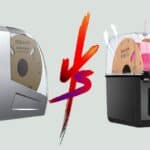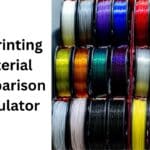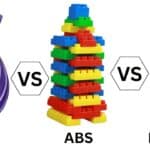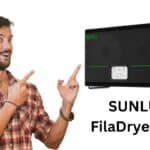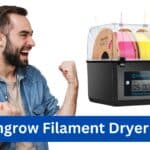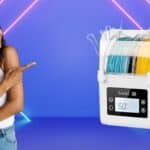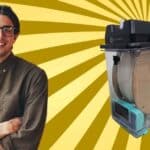
The Sunlu Filadryer S4 excels for multi-spool 3D printing projects, while the Polymaker PolyDryer is ideal for compact, single-spool decor printing. Choose based on capacity and space needs for flawless 3D printed decor.
Moisture in 3D printing filament can ruin 3D printed home decor, causing stringing, clogging, poor adhesion, and layer shifting. For hobbyists crafting vases, wall art, or custom kitchen organizers, a reliable filament dryer is essential. This article compares the Sunlu Filadryer S4 and Polymaker PolyDryer, evaluating drying capacity, filament compatibility, and price, while addressing common questions about filament drying and material choices. In this Sunlu Filadryer S4 vs Polymaker PolyDryer article, we’ll also provide practical tips, troubleshooting advice, and complementary tools to ensure flawless decor prints. For detailed filament settings, see our 3D Printer Filament Compatibility Guide 2025.
Affiliate Disclosure
We participate in Amazon affiliate programs, earning fees from qualifying purchases via links at no extra cost to you. It’s how we keep this blog rolling and my 3D printers buzzing with fresh filament for reviews like this one!
Related: Top 5 3D Printer Filament Racks – Guide to filament storage solutions, complementing dryers for moisture-free filament.
Why Do We Need Filament Dryers?
Most 3D printing filaments, like PLA, PETG, TPU, and Nylon, are hygroscopic, absorbing moisture from the air. This moisture causes issues like stringing, bubbling, or poor layer adhesion, ruining intricate decor prints such as 3D printed dragons or Diwali decorations. For example, wet TPU may snap during printing, while moist PETG produces stringy, weak plant pots. Drying filament ensures consistent extrusion, especially in humid environments (70%+ humidity, considered very humid), which exacerbates moisture absorption. High humidity can also make polyurethane-based filaments like TPU sticky or brittle, though it doesn’t dehydrate users.
Related: The Best Filament Dryers for 3D Printing: Top 5 Picks – Comprehensive guide to top filament dryers, including Sunlu S4 and Polymaker PolyDryer.
What Is Considered Dry Filament?
Dry filament has a moisture content below 15-20% relative humidity (RH), as measured by a hygrometer in a sealed dry box. The Polymaker PolyDryer maintains humidity below 15% RH, while the Sunlu S4 targets 25% RH in its humidity control mode. Dry filament prints smoothly without popping noises or surface defects, ensuring decor items like wall hooks or coffee mugs meet aesthetic and structural standards.
Related: Sunlu Filadryer S4 Review – Detailed review of the Sunlu Filadryer S4, perfect for multi-spool decor projects.
What Happens If You Don’t Use a Filament Dryer?
Printing with wet filament leads to stringing, clogging, poor adhesion, and brittle filament, halting prints. Tests with wet TPU showed significant stringing, while drying it for 5-6 hours in the Sunlu S4 improved print quality markedly. In humid climates, these issues are amplified, especially for Nylon or PETG. Learn more about fixing adhesion issues in our guide to first-layer adhesion problems.
Related: Polymaker PolyDryer Review – In-depth look at the Polymaker PolyDryer, ideal for compact setups.
Sunlu Filadryer S4 vs Polymaker PolyDryer
Sunlu Filadryer S4: High-Capacity Workhorse
The Sunlu Filadryer S4 is designed for users needing to dry multiple spools, ideal for multi-color decor projects or print farms. Read our full Sunlu Filadryer S4 review for more details.
- Drying Capacity: Holds up to four 1kg spools (450 x 175 x 207 mm internal size), with eight filament outlets (four on top, two on each side) for feeding multiple printers. Users report fitting up to six spools with creative setups, though it’s officially rated for four. It can be modified for one 3kg spool, but the provided STL files have been criticized for poor design.
- Filament Compatibility: Supports PLA, PLA Plus, PLA Meta, PETG, ABS, TPU, PA (Nylon), PC, and more, with 1.75mm, 2.85mm, and 3.00mm diameters. Pre-configured settings simplify drying, though users must avoid overheating low-temperature filaments like PLA. See our filament comparison guide.
- Heating and Technology: Features a 350W PTC heater, reaching 50°C in 30 minutes and a maximum temperature of 70°C. Three fans ensure even 360° heat distribution (±3°C balance), though some report hot spots. Intelligent humidity control (30%-50% RH, stops at 25%) and desiccant pockets enhance efficiency.
- Design and Usability: Large (460 x 220 x 310 mm, 4kg), with a touchscreen for adjusting temperature (35-70°C) and timer (0-99 hours). Users praise its quiet operation but criticize finicky lids and occasional reliability issues (e.g., failure after four months).
- Price: $139.99 with 7% savings on Amazon. Buy now.
Pros:
✅ High capacity for four 1kg spools, ideal for multi-color decor projects
✅ Eight filament outlets for versatile multi-printer setups
✅ Fast 350W PTC heater with 70°C max temperature
✅ Three fans for even heat distribution (±3°C)
✅ Robust humidity control (30%-50% RH)
✅ Wide filament compatibility (PLA, PETG, ABS, TPU, PA, PC)
Cons:
❌ Large footprint unsuitable for small workspaces
❌ Finicky lids difficult to secure or open
❌ Potential hot spots despite fans
❌ Some reliability concerns (e.g., unit failure after four months)
Best For: Multi-printer setups or large decor projects like sustainable decor or multicolor prints.
Related: Sovol SH01 Filament Dryer 2025 Review – Budget-friendly filament dryer for 3D printing enthusiasts.
Polymaker PolyDryer: Compact and Modular
The Polymaker PolyDryer prioritizes modularity and storage, perfect for hobbyists with limited space. Check our Polymaker PolyDryer review for in-depth insights.
- Drying Capacity: Dries one 1kg spool per PolyDryer Box (205 x 78 mm), with a modular design allowing additional boxes for storage. The “Double Barrel Mod” enables drying two boxes simultaneously.
- Filament Compatibility: Supports PLA, PVB, PETG, ABS, ASA, TPU, PA, PC, PVA, and PolySupport for PA12, with 1.75mm, 2.85mm, and 3.00mm diameters. A printed guide lists drying settings.
- Heating and Technology: Uses a PTC heater with three preset power levels, reaching ~60°C air temperature (filament ~53°C). Features 360° airflow, a color-changing desiccant, and a hygrometer for humidity monitoring (<15% RH). Users note superior sealing for long-term storage.
- Design and Usability: Compact (1.3kg, 29cm height), with a sturdy, airtight PolyDryer Box. The dock-box connection isn’t fixed, which some find convenient but others cumbersome. The fan is noticeable but not intrusive, and the tight lid can be hard to open.
- Price: $79.99 with 9% savings on Amazon. Buy now.
Pros:
✅ Compact design (29cm height, 1.3kg) for small workspaces
✅ Modular system with add-on PolyDryer Boxes for storage
✅ Superior sealing with hygrometer and desiccant (<15% RH)
✅ 360° airflow for even drying without filament damage
✅ Compatible with PLA, PETG, ABS, TPU, PA, PC, PVA
✅ Community mods enhance versatility
Cons:
❌ Limited to one 1kg spool (two with mod)
❌ Fan noise noticeable in quiet settings
❌ Loose dock-box connection may feel cumbersome
❌ Tight lidស
Best For: Hobbyists creating 3D printed lighting or Easter decorations.
Related: Kingroon Filament Dryer Box 2025 Review – Review of Kingroon’s dryer box for filament drying needs.
Comparison Table
| Feature | Sunlu Filadryer S4 | Polymaker PolyDryer |
|---|---|---|
| Drying Capacity | Up to 4x 1kg spools (or one 3kg with mod) | 1x 1kg spool (2x with Double Barrel Mod) |
| Filament Compatibility | PLA, PETG, ABS, TPU, PA, PC, 1.75/2.85/3.00mm | PLA, PETG, ABS, TPU, PA, PC, PVA, 1.75/2.85/3.00mm |
| Max Temperature | 70°C (50°C in 30 mins) | ~60°C (filament ~53°C) |
| Heating Technology | 350W PTC heater, 3 fans, ±3°C balance | PTC heater, 360° airflow, 3 power levels |
| Humidity Control | Auto 30%-50% RH, stops at 25%, desiccant pockets | Hygrometer, color-changing desiccant, <15% RH |
| Size | 460 x 220 x 310 mm, 4kg | 29cm height, 1.3kg |
| Buy Now | Get the Sunlu S4 Now | Get the PolyDryer Today |
| Best For | Multi-spool, multi-printer decor projects | Compact, single-spool decor printing with storage |
Related: Creality Space Pi vs. Space Pi Plus Review - Compares Creality’s filament dryers, focusing on moisture control.
How to Use a Filament Dryer for Decor Projects
To achieve flawless 3D printed decor, follow these steps:
- Select Your Filament: Choose a filament suited for your project (e.g., PETG for waterproof vases, silk PLA for cosplay props).
- Set Temperature and Time: Use the chart below for optimal settings.
- Load and Monitor: Place the spool in the dryer, ensure proper sealing, and check humidity levels (aim for <20% RH).
- Print Directly: Feed filament through outlets (Sunlu S4) or PTFE tubes (PolyDryer) for seamless printing.
- Store Properly: Store in a sealed box with desiccant or on a filament rack.
Related: Creality Space Pi Plus Filament Dryer vs. Comgrow Filament Dryer Box - Comparison of two popular filament dryers for decor printing.
Drying Times for Decor Filaments:
| Filament Type | Sunlu S4 Drying Time (Hours) | Polymaker PolyDryer Drying Time (Hours) | Recommended Temperature (°C) |
|---|---|---|---|
| PLA | 4 | 5 | 35-45 |
| PETG | 6 | 7 | 45-55 |
| TPU | 6 | 7 | 45-50 |
| ABS | 8 | 9 | 50-60 |
| Nylon | 12 | 14 | 55-65 |
Related: Comgrow Filament Dryer Box Review - Evaluates Comgrow’s dryer for effective filament drying.
Troubleshooting Common Drying Issues
- Over-Drying PLA: PLA can become brittle if dried above 45°C. Use the Sunlu S4’s low-temperature setting (35°C) for 4-5 hours.
- Uneven Drying: If Nylon prints show bubbles, increase drying time by 2 hours and rotate spools in the Sunlu S4 to avoid hot spots.
- Fan Noise (PolyDryer): Place the PolyDryer on a foam pad to reduce noise, especially in quiet workspaces.
- Humidity Not Dropping: Ensure proper sealing and replace desiccants if saturated. Check our filament storage guide for tips.
Learn more about fixing print issues in our guide to 3D print failures.
Related: Creality Official Filament Dryer Box 2.0 Review - Review of Creality’s updated filament dryer for 3D printing.
Frequently Bought Together
Dry & Dry" Silica Gel Desiccant Beads
2 Pack Mini Digital Hygrometer Thermometer Gauge
Boveda 69% Two-Way Humidity Control Packs For Plastic and Wood Containers
SUNLU PLA+ 3D Printer Filament Pack (0.25kg Each Spool, Total 2kg, 1.75mm, 8 Packs)
People Also Ask
Is Polymaker Filament the Best?
Polymaker’s PolyLite (PLA, PETG) and engineering-grade filaments (PA, PC) are top-tier for consistency and specialty uses in decorative 3D printing. Brands like Sunlu or Prusament are cost-effective alternatives. PolyLite PETG excels for durable plant pots. See our top 5 filaments guide.
What Is the Highest Temperature for a Polymaker PolyDryer?
The PolyDryer reaches ~60°C air temperature (filament ~53°C), sufficient for PLA, PETG, and Nylon but potentially limiting for high-temperature materials.
Is the PolyDryer Good?
Yes, its compact design, superior sealing, and hygrometer ensure long-term storage, with community mods like the Double Barrel Mod adding versatility. Users report improved PETG print quality for custom decor.
What Is the Maximum Temperature for Sunlu S4?
The Sunlu S4 reaches 70°C, ideal for PLA, PETG, ABS, and Nylon, but care is needed to avoid overheating PLA.
What’s the Best Filament Dryer for 3D Printed Decor?
The Sunlu S4 is best for multi-spool, multi-color projects, while the PolyDryer suits compact setups. Alternatives like the Creality Space Pi Plus or Sovol SH01 are budget-friendly but less versatile. See our top 5 filament dryers.
Is Creality Space Pi Good?
The Creality Space Pi is compact and budget-friendly for PLA or PETG but has less accurate temperature control and poor insulation. It’s suitable for small decor projects.
Is Polymaker a Chinese Company?
Polymaker is headquartered in Shanghai, China, with global operations. Some PolyLite filaments are made in the USA, per Polymaker US Wholesale.
Who Is the Owner of Polymaker?
Dr. Xiaofan Luo, CEO, co-founded Polymaker, focusing on innovation and community-driven products.
Is Polymaker Made in the USA?
Some PolyLite filaments are USA-made, while others are imported as operations scale.
Are PolyLite and Polymaker the Same Company?
Yes, PolyLite is Polymaker’s filament brand, ideal for 3D printed gifts.
What Is the Best 3D Printer Filament?
PETG is durable for kitchen organizers, while PLA suits aesthetic Easter decorations. See our ultimate filament guide.
Why Use PETG Over PLA?
PETG offers greater strength and temperature resistance (70°C vs. PLA’s 55°C) for functional decor like vases. PLA is easier for aesthetic wall posters. See PLA vs. ABS vs. PETG.
Is ASA Better Than ABS?
ASA’s UV resistance makes it better for outdoor garden pots. ABS is cost-effective for indoor use but requires ventilation.
Which Is Better, ABS or PLA?
ABS is stronger and heat-resistant (80°C) for functional decor, but PLA is eco-friendly for aesthetic home accessories.
What Is Stronger Than PLA?
PETG, ABS, ASA, Nylon, and PC are stronger. PETG is versatile for decor, while Nylon and PC suit high-stress parts. See our filament tier list.
How Do I Store Filament After Drying?
Store in a sealed container with desiccant or on a filament rack to maintain dryness.
Can I Dry Filament Without a Dryer?
Yes, using an oven (40-50°C) or food dehydrator, but dryers like the Sunlu S4 offer precise control. Avoid overheating PLA.
How Does Humidity Affect 3D Printing?
High humidity (>60%) causes moisture absorption, leading to poor print quality. Pair dryers with an air purifier to control workspace humidity.
What Filaments Are Best for Outdoor Decor?
ASA and PETG are UV-resistant and durable for outdoor plant pots. Dry thoroughly to avoid moisture issues.
Complementary Tools and Printers
Enhance your dryer with:
- 3D Printer Enclosures: Stabilize printing conditions for multicolor prints.
- Air Purifiers: Reduce fumes from ABS or Nylon.
- Creality CR-Touch: Ensure precise bed leveling for flawless decor prints.
- Printers: Pair with the Flashforge Adventurer 5M for budget-friendly decor or Anycubic Kobra 3 Combo for multicolor projects.
Related: Sunlu Filament Connector Review - Explores a complementary tool for filament management, useful with dryers.
Safety and Maintenance Tips
- Safety: Use a 3D printer enclosure and safety gear when drying ABS or Nylon to minimize fumes.
- Maintenance: Clean the Sunlu S4’s fans monthly and replace PolyDryer’s desiccant when saturated. See our 3D printer maintenance guide.
Which Dryer Perfects Your Decor Prints?
- Choose Sunlu Filadryer S4 for multi-printer, multi-color projects (e.g., Diwali decor). Its high capacity and 70°C max temperature handle diverse filaments, though it demands space.
- Choose Polymaker PolyDryer for small workspaces or single-spool prints (e.g., 3D printed lighting). Its compact design and sealing are ideal for hobbyists.
Both dryers prevent moisture-related issues for high-quality 3D printed decor. Try our 3D Printer Comparison Tool to find the best setup.
Join the 3D Printing Community
Printed a stunning 3D printed coffee mug? Share your drying tips or decor projects in the comments or on 3D printing community sites. Sell your creations on Etsy with our selling guide or explore profitable 3D printed products.
Ready to perfect your decor prints? Choose your dryer, pair it with a top 3D printer, and start creating stunning home decor today!







